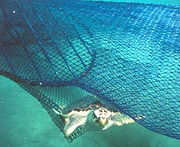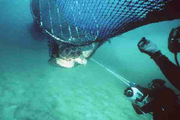
Turtle excluder device
Encyclopedia

Sea turtle
Sea turtles are marine reptiles that inhabit all of the world's oceans except the Arctic.-Distribution:...
to escape when caught in a fisherman's net.
In particular, sea turtle
Sea turtle
Sea turtles are marine reptiles that inhabit all of the world's oceans except the Arctic.-Distribution:...
s can be caught when bottom trawling
Bottom trawling
Bottom trawling is trawling along the sea floor. It is also often referred to as "dragging".The scientific community divides bottom trawling into benthic trawling and demersal trawling...
is used by the commercial shrimp fishing industry
Shrimp fishery
A shrimp fishery is a fishery directed toward harvesting either shrimp or prawns. .-Commercial shrimping:...
. In order to catch shrimp
Shrimp
Shrimp are swimming, decapod crustaceans classified in the infraorder Caridea, found widely around the world in both fresh and salt water. Adult shrimp are filter feeding benthic animals living close to the bottom. They can live in schools and can swim rapidly backwards. Shrimp are an important...
, a fine meshed trawl net
Trawling
Trawling is a method of fishing that involves pulling a fishing net through the water behind one or more boats. The net that is used for trawling is called a trawl....
is needed. This results in large amounts of other marine organisms being also caught as bycatch
Bycatch
The term “bycatch” is usually used for fish caught unintentionally in a fishery while intending to catch other fish. It may however also indicate untargeted catch in other forms of animal harvesting or collecting...
. When a turtle gets caught or entangled in a trawl net, it becomes trapped and is unable to return to the surface. Since sea turtles are air-breathing creatures with lung
Lung
The lung is the essential respiration organ in many air-breathing animals, including most tetrapods, a few fish and a few snails. In mammals and the more complex life forms, the two lungs are located near the backbone on either side of the heart...
s, they eventually drown.
History
TEDs were first developed in the 1970s by a fisherman named Sinkey Boone, seeking to reduce his by-catchBy-catch
The term “bycatch” is usually used for fish caught unintentionally in a fishery while intending to catch other fish. It may however also indicate untargeted catch in other forms of animal harvesting or collecting...
. His invention was called The Georgia Jumper. It is an original one of a kind design. Another style was patented on April 26, 1988 by inventor Noah J Saunders of Biloxi, Mississippi. By decreasing the number of unwanted fish and creatures caught in their trawl nets, fishermen could trawl longer with the same net ideally catching more shrimp. Some resistance to the use of TEDs has arisen from the belief that the use of the devices actually causes fishermen to lose shrimp and other targeted species.
In 1987, the United States
United States
The United States of America is a federal constitutional republic comprising fifty states and a federal district...
required all trawling shrimping boats to equip their nets with turtle excluder devices. As a follow-up two years after, the shrimp-turtle law was implemented. This required all countries that the USA was import
Import
The term import is derived from the conceptual meaning as to bring in the goods and services into the port of a country. The buyer of such goods and services is referred to an "importer" who is based in the country of import whereas the overseas based seller is referred to as an "exporter". Thus...
ing shrimp from to certify that the shrimp they shipped were harvested by boats equipped with TEDs. Countries that cannot guarantee the use of the escape devices were banned from export
Export
The term export is derived from the conceptual meaning as to ship the goods and services out of the port of a country. The seller of such goods and services is referred to as an "exporter" who is based in the country of export whereas the overseas based buyer is referred to as an "importer"...
ing shrimp to the USA.
In 1996, the India
India
India , officially the Republic of India , is a country in South Asia. It is the seventh-largest country by geographical area, the second-most populous country with over 1.2 billion people, and the most populous democracy in the world...
n government proposed legislature for the requirement of modified "indigenous" TEDs, which they called TSDs (Turtle Saving Devices) to be used by local fishermen. This was a response to the declining olive ridley population that were nesting in beaches such as in Orissa
Orissa
Orissa , officially Odisha since Nov 2011, is a state of India, located on the east coast of India, by the Bay of Bengal. It is the modern name of the ancient nation of Kalinga, which was invaded by the Maurya Emperor Ashoka in 261 BC. The modern state of Orissa was established on 1 April...
. The modified TSDs were similar to standard TEDs except for having fewer bars. This resulted in the increase of the distance between each pair of bars to ensure that bigger specimens of shrimp and fish were able to pass through the TSD and into the net.
Even in United States
United States
The United States of America is a federal constitutional republic comprising fifty states and a federal district...
use of TEDs is not universal. As of June 2010, the State of Louisiana has prohibited its marine enforcement officers from enforcing TED and tow time limits.
Mechanism
The use of the devices ideally allow all bycatch larger than ten centimeters (10 cm.) to escape the nets unharmed. This selectivity is achieved by metal grids integrated into the trawl net structure. The grids act as a barrier for large creatures such as turtles from passing through the bars into the back of the net.A small opening in the net is then available either above or below the grid so that the creatures that are stopped by the TEDs are allowed to escape the net, relatively unharmed. Targeted species such as shrimp however, are pushed to the back of the net. The target design effectiveness of TEDs is 97%. But the field effectiveness is often far lower. Seagrasses and other debris reduce fishing effectiveness of TEDs and in some situations may block sea turtles from exiting the net. In addition, it is easy to tamper with TEDs so as to increase the fishing efficiency of the net, while eliminating the turtle-excluding properties of the TED.
Failings and drawbacks

It has been acknowledged that the larger sea turtles, primarily large loggerheads and leatherbacks are too large to fit through the escape hatches installed in most TEDs. These turtles remain trapped within the net and perish. U.S. legislation introduced in 2003 has attempted to address this issue by increasing the size of the escape chutes in the devices.
It is difficult to enforce TED compliance The problem is that TEDs reduce the efficiency of the net system, resulting in a loss of some of the catch. On a per boat basis, turtles are rarely caught, only one turtle per 322.5 hours in the Gulf of Mexico. This creates an incentive for the trawler to cheat. The catch loss can be eliminated by simply tying the turtle escape opening shut with a tie. The tie is removed when the vessel returns to port, thus avoiding detection by enforcement officers, but placing turtles at risk while trawling. It has been theorized that the spike in dead turtles seen in the Gulf of Mexico in June and July 2010 was due to shrimp boats that were taking advantage of lax marine enforcement due to the gulf oil spill.
Occasionally TED use becomes impractical due to debris in the water. When a TED is clogged with debris, it can no longer catch fish effectively or exclude turtles. For example, in September 2008 following Hurricanes Gustav and Ike, the National Marine Fisheries Service (NMFS) allowed temporary use of "Tow Times" in lieu of TEDs . Vessels were required to limit their tows to 55 minutes from the time the trawl doors entered the water until they were retrieved from the water. In June 2010 the limit was further reduced to 30 minutes. Unfortunately vessels were not equipped with tow time data loggers, so there was no practical method to enforce these time limits.
The TTED
The TTED (Trash and Turtle Excluder Device) is a recent refinement of the TED, which, as well as turtles, can additionally free other form of bycatch. The TTED reduces sorting time and risks of injury due to sharks and rays being caught, improves the quality of shrimps, which are less likely to be crushed in the bottom of the trawl, and may also lead to a reduction in the amount of fuel consumed by the boats.The TTED is the culmination of years of research. With funding provided by the European Union and the DIREN (Regional Environmental Authorities), WWF commissioned a study from IFREMER (French Research Institute for Exploitation of the Sea) to determine which selective gear was the most adapted to fishing conditions in French Guiana. These initial trials, conducted under experimental conditions, were carried out on board a shrimp trawler. Following this work, shrimp industry’s members expressed the need to continue these experiments and to become more involved in the project. In response, WWF and the CRPMEMG (French Guiana Regional Fishery and Ocean Farming Committee) began working in close collaboration in order to test and develop the best gear for the French Guiana fleet.
With technical support from NOAA and IFREMER, the CRPMEMG carried out numerous at sea trials in close collaboration with French Guiana fleets. Specific parameters where tested such as the shape and spacing between the bars of the selective grid. These trials allowed the fleets and the crews onboard the shrimp trawlers to understand the advantages of a more selective fishing gear and the benefits of using it in French Guiana. Based on the results and the captains’ recommendations, the CRPMEMG decided to make the use of this TTED system mandatory by January 2010, when the annual fishing licences are issued. Many Captains were already using the TTED device on their shrimp trawlers well before January 2010.
The TTED was developed by the CRPMEMG and fishermen with the assistance of NOAA, IFREMER, the French Ministry of Agriculture and Fisheries, Région Guyane, the European Fund for Fisheries (FEP) and the WWF.

